
In the mid-2000s, following our birth-to-three research, we began to examine practice in early childhood education and care (ECEC) for children up to two years of age in day nurseries in South East England. This research became formalised as the original Baby Room Project when the Esmée Fairbairn Foundation agreed to fund two phases of research and development work, starting in 2009.
Our intention was to better understand practice with babies and to work with practitioners to research and support their work. The project also supported opportunities for participants to develop networks across different settings in order to discuss practice, research evidence, policies, theories and the principles that shape this.
In phase two of the project, which began in 2012, the work was extended to include a group of local authority early years advisers. They devised and carried out a series of case studies focusing on specific aspects of baby room practice. These were later drawn together for the purposes of the research and to feed into the authorities’ ongoing work to improve provision and practice across the region.
What was the impact of the project at this stage?
We have published our key findings and observations in books, articles and summary reports. The research led to:
- the creation of new local procedures, including specialist CPD for baby room staff
- raised awareness of the complexities of baby room work, including informing the Nutbrown Review of Childcare and Early Years Qualifications
- the establishment of special interest groups within national organisations, such as Early Education
- a new acknowledgement of the relative lack of professional learning opportunities that existed for baby room staff.
An enduring legacy of the original Baby Room Project work is our ongoing support for critically reflexive dialogue and networking among colleagues whose professional interests or studies focus on education and care for babies and toddlers. This includes the formation of an online social networking site called The Baby Room NING, and the Annual Baby Room Conference, which is now in its eighth year and brings internationally renowned keynote speakers together with a multi-professional delegate body to discuss and debate ECEC for babies and very young children.

Has the project reached beyond the UK?
Yes. We’ve had invitations to share processes and findings internationally – in mainland Europe, Asia, Australasia, and North and South America. And we have remained in close contact with colleagues in Scotland and the Republic of Ireland, as well as further afield in Belgium, mainland China and Hong Kong, New Zealand, Australia and the USA.
Where the project caught the attention of, and inspired, colleagues, it led to change – for example, a new academic, undergraduate programme for early childhood studies in Germany; an enhanced focus on educational provision for babies in parts of China; as well as ongoing interest from colleagues around the UK and other parts of the world.
Why was there a need for a Baby Room Project and does this need still exist?
When we first began our Baby Room Projects, we found a relatively ‘invisible’ practice within ECEC. We found that there were practitioners working with babies who were frequently the youngest, least-experienced and least-qualified in the nursery. Within our project groups, participants told us that they felt neglected and were unable to access specialist professional development designed for those working with children under two. ECEC policy documents and guidance frequently talked about young children without specifically making reference to babies, which also contributed to their sense of neglect.
We are pleased that now at least babies are more frequently referenced in documentation; projects supporting practice with babies are developing around the country; in some provision, in-house professional development is being provided; and internationally, greater attention is being given now to this phase of ECEC. However, there still exists a distinct need for baby room practice to be given more attention, to become more visible, and for specialist professional development programmes to be developed across the country.
There is an urgent need for financial investment into the care of babies to ensure that those caring for the youngest in our ECEC systems are among the most-qualified, the most-experienced practitioners, and feel fully supported in their role.
Equally, those who support them and make judgements about their practice need to be offered opportunities to enhance their own knowledge and understandings of the particularities of baby room work. Policy-makers too need to be reminded of the importance and value of this phase of ECEC primarily as provision for babies, rather than thinking about it simply as a convenience for parents.
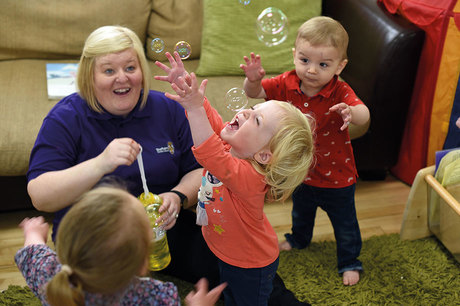
Are you still working on the Baby Room Project?
Since 2014, the Baby Room Project has formed the basis for two further research and development projects, which we have designed and led, based in the South East of England.
The Froebel Trust supported a two-stage research project, beginning with a pilot study, Mother Songs in Daycare for Babies. It drew on the philosophical and pedagogical writings of Friedrich Froebel and reviewed contemporary literature which offered a research landscape for singing with babies. A key aspect of the data collection for this project was an audit of the song repertoire and practices of project participants. We learned that the songs that babies were encountering in baby rooms were most frequently ‘play songs’ or action songs. Lullabies were infrequent or non-existent in practice.
Stage two of the work delved more deeply into the underlying reasons for a paucity of close, one-to-one talk and singing with babies. Based on Froebel’s philosophy, which encouraged emotional connectedness and affective encounters, the project sought to examine the place of emotions in infant pedagogy.
The second project was Babysong, funded by the Ragdoll Foundation, which supported professional development activities with a new group of participants drawn from baby rooms in the South East. In this project, we reached a new group of baby room practitioners and worked with them to support singing with babies, incidentally or opportunistically, as well as in planned sessions. With the support of Vanessa Young, a music specialist, we helped participants to explore the benefits of singing with babies and the abilities of babies to respond effectively to song.
Now, we are particularly proud to be collaborating with the team who have worked extremely hard to create their own Durham Baby Room Project (see case study, right). The early findings from this work are extremely encouraging and we think that the enthusiastic work that has been developed there will serve as a useful model for other regions to emulate. One of the aspects of this project that has been particularly rewarding is the way that the Durham team has picked up on the dialogic approach to professional development, which has been a central theme of our work.
Also, a year ago at the seventh annual Baby Room Conference, the Bristol team arrived in a minibus and left at the end of the day full of enthusiasm and energy – apparently inspired to take this work into their region. This year, the 2017 conference heard about the emerging work with baby rooms that has now begun in Bristol (see page 24).
We have also been busy researching other aspects of babies’ education and care and exploring the transferability of messages from this work for ECEC provision and practice. These studies include The Birth of Conversation; evaluation of an app for expectant and new mothers and their healthcare professionals; continuity of care in ECEC settings in the USA; and a study, with colleagues at Roehampton University, of the ways that the key person approach is articulated in Ofsted reports.
What have you learned from your Baby Room Projects?
From engagement with practitioners through our projects, immersion in literature and research data, discursive opportunities with colleagues through conferences and academic networks, and ongoing data analysis, we have begun to frame a portrait of baby room practices – locally, nationally and internationally.
Rather than creating intimate, 1:1 engagement with individual babies in their care, practitioners talked of responding to functional, timetabled events, the structures and patterns of the day, and preordained ‘scripts’ informing practice.
In the Babysong project, practitioners reported the need to present themselves as ‘busy’, as ‘performing care’ and as ‘lively’ in the baby room. As a result, opportunities for both babies and their carers to enjoy the benefits of stillness were rare. As in previous projects, dialogue played a central role in our methodology, with participants’ stories enabling us to work collectively to reflect upon and theorise baby room practices.
Our focus on adult-baby engagement raised a number of questions about the importance of intimacy, talk and respectful engagement with babies. However, the performance of care seems to prevent practitioners from being still in the company of babies, and from enjoying relatively quiet, conversational or lulling times during the day.
We found that our projects, and conferences, were contributing to a previously neglected sector of practitioners’ professional development, with some participants in our projects reporting still feeling isolated in their work.
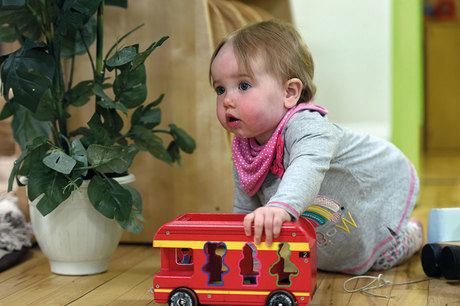
What would you say to parents, managers and policy-makers?
In our projects, practitioners talked about how responsible they felt their job was, caring for ‘the most precious thing in parents’ lives’. Our project participants were excited about learning more about their job, about sharing aspects of practice with colleagues in the same position, and about learning from research as well as policy.
They helped us to understand the physical, emotional and intellectual demands of their jobs and reflected on the impact and influence of public and policy perceptions of their roles, responsibilities and status.
We would say to all ‘stakeholders’ in baby room practice that the practitioners who worked with us through our projects invested in their work with babies and, in return, they deserve investment in their professional development, learning, career progression, work environment, pay and conditions. Working in a baby room is important work.
Dr Kathy Goouch is professor of early education and Sacha Powell is director of the Research Centre for Children, Families and Communities at Canterbury Christ Church University.
More information
- For information on all elements of the Baby Project, including links to publications and presentations, visit: www.canterbury.ac.uk/education/our-work/research-knowledge-exchange/research-centre-for-children-families-communities/baby-room/about.aspx
- ‘Froebel – Special songs’ by Kathy Goouch, Sacha Powell and Louie Werth, www.nurseryworld.co.uk/nursery-world/feature/1155184/learning-development-froebel-special-songs
- ‘Music – Be still’ by Vanessa Young, www.nurseryworld.co.uk/nursery-world/feature/1152552/learning-development-music-be-still
- ‘Baby rooms – Still room for improvement?’ by Hannah Crown, www.nurseryworld.co.uk/nursery-world/feature/1152267/baby-rooms-still-room-for-improvement
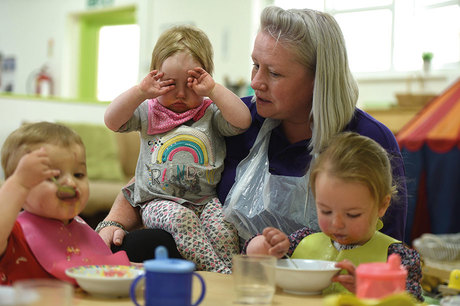
CASE STUDY: DURHAM
Durham is aiming to make baby room practitioners more reflective. Annette Rawstrone finds out how
The need to value, invest in and inspire baby room practitioners was identified by the local authority early years service in County Durham. It launched the Baby Room Project with a conference in September last year with Professor Kathy Goouch as the keynote speaker.
The project aims to:
- increase the knowledge of baby room practitioners and managers, focusing on research information and its impact on practice
- increase opportunities and experiences offered to under-twos in daycare baby rooms
- share professional dialogue and develop relationships between provisions to extend knowledge.
Initially, it was planned to offer training opportunities but, explains early years advisory officer Sonia Berry, it was decided that this would be a ‘sticking plaster approach’, and it would be preferable to have continual reflective practice to encourage practitioners to think about what they do and why and how it impacts on their practice. This was delivered through one-to-one guidance and monthly group meetings lasting half a day, enabling the 13 practitioners committed to the project to share experiences and become a learning community.
‘For example, one practitioner looked at the benefits of outdoor sleep and researched what is done in Norway and Sweden. Rather than just lifting that work, as they would have done before, they made it real for their own nursery in County Durham by researching, understanding and clearly articulating the benefits,’ explains Ms Berry.
Others have considered what ‘quality time’ really means and changed their routines to enable this to happen, made changes to their environment and introduced more outdoor play opportunities. ‘At first it was difficult to meet with no agenda because people wanted to be told what to do, but they soon saw the importance of the reflective sessions,’ Ms Berry adds.
It was identified that many of the baby room practitioners were lacking in confidence and self-esteem, but through the project they have grown to value their role and feel proud of their work. Many report that they now reflect on their practice continually, and the impact that it has on the babies.
The project ended with a celebratory conference in June, but it will continue with cluster groups of baby room practitioners across the county and additional professional opportunities specifically for those working with babies.
‘The impact has been really lovely, with practitioners sharing what is happening in their baby rooms, connecting and having the opportunity to talk to people in the same job and share ideas,’ says Ms Berry. ‘They were the forgotten workforce, but now they feel like a group of professionals because they’ve had these opportunities.’

On reflection:
Selby Cottage Childcare Centre, Chester-le-Street
‘Meeting up with other baby room practitioners has made me go back to basics and I’ve rethought the importance of attachment and the need for babies to have cuddles and their emotions met. It’s good to chat with the others about what they are doing and bounce off ideas,’ says childcare assistant Emma Hayley.
‘My line of enquiry is how much physical contact I have with my key group. When I first started working in the baby room, a mother requested I carry her son in a papoose. Thinking of this made me reconsider what physical contact I have with children.
‘Following a timescale observation over a month, we are now giving more time to the bathroom routines so that we have quality time chatting and playing as we change nappies or wash faces. Now when we read stories we do it in little huddles on the sofa. We’re increasing close, quality time.
‘Since starting the project my confidence has increased. I’m happy to speak out, give feedback to my co-workers and suggest we try new ideas, such as seeing if the children benefit from having song time earlier in the day. We plan on continuing our monthly group meetings and setting up a social network to keep sharing ideas and asking questions.’
Positive Steps Day Nursery, Peterlee
‘I feel, even among childcare practitioners, working in the baby room can be looked down on as “just playing” and the importance of the connections and attachments that we are making can be overlooked.
‘Being part of the Baby Room Project has been amazing. It’s such a boost to see the impact of the changes that we’ve made,’ says nursery officer Joe Young.
‘We have a big baby room with 16 children and we used to separate the non-mobile children, which meant that children could not always access their key person.
‘We gave thought to opening up the room – Will the babies be safe? Will the parents like it? Will it work? – and are really pleased that we have. We’re now more available to all the children, and parents say how lovely, cosy and inviting we’ve made the room.
‘There’s now a sofa to feed the babies on and a double mattress on the floor with cushions and throws for them to crawl on.
‘The project has made me feel more empowered and given me more respect for myself as a baby room practitioner. We think, listen and observe a lot more and we’re going to continue working in this way and set up our own baby room research group.’
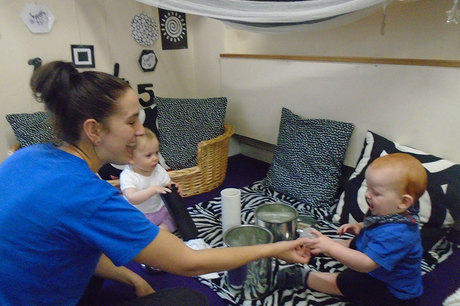
CASE STUDY: BRISTOL
Bristol is raising quality in baby room practice through action research, say Rachel Pirie, Carole Keane, Matt Caldwell, Rosie McCallum and Elizabeth Carruthers
n Bristol, the early years community has moved away from the conventional route of improving practice through training to effecting change through action research. This, we believe, is the most valuable form of CPD, because it belongs to the practitioner and so can transform practice in a way that is sustainable.
In order to gather opinions from the field, we met with colleagues from nurseries and children’s centres in Bristol. We felt strongly that our way of working is growing a learning community and developing, what Appleby and Andrews (2011) have described as ‘thoughtful agents’. These are practitioners who reflect on and seek to improve provision. We wanted to extend the professional development of those involved and build upon their thoughts alongside our own.
At these meetings, we debated our image of the baby and began to sculpt what would become our ‘Rights of the Baby’ (see below). Each right was informed by our experiences of working with, and in, baby rooms in the city and reflected our aspiration that the particular needs of babies are acknowledged and valued.
These rights became a vehicle for discussion and enabled us to focus more sharply on the purpose of our research. The dialogue had been a catalyst, and the process of capturing these rights together had enabled a process of reflection which continues to thread throughout our research. Before gathering relevant data from settings, we considered some ethical questions:
- How would a setting feel about an outside observer coming in to ask questions?
- How did we know our questions would provide interesting data?
- Was the process viable, given the limitations of time and funding?
We decided to first run pilot visits, then reconsidered our questions and thought about the value of what we had observed to inform our next steps.
Most reactions to our enquiries were positive, and each setting knew that in return for answering our questions and allowing us to just ‘be’ in their baby room, they would receive some materials – the ‘image of the baby’ and ‘rights of the baby’ materials, as well as an invitation to join in some professional development.
As we are practitioners ourselves, and have other job roles that involve visiting a wide variety of settings, we are well versed in being ethnographic and embedded researchers rather than detached scientists. This helped us navigate through the different rooms and make sense of the different practice we had observed.
Key person
Page and Elfer (2013) identified the importance of young children having close attachments with their familiar adults when cared for away from their parent(s). Most settings we visited focused on relationships with the children and families when asked about the role of the key person. One practitioner said, ‘Get to know the child and family and be their port of call’, while others talked about bonding.
Only one of the 14 settings we have visited so far did not value the role of the key person, reflecting the findings of Ebbeck and Yim (2009) that ‘there is some evidence of failure in some nurseries to successfully implement the key person approach in relation to notions of close attachment’.
Some were committed to the intimate care of their key children, working closely with the parents to follow individual routines, especially with the younger babies. This links with the notion of ‘professional love’, which Jools Page (2011) asserts is ‘the essential ingredient in caring for and educating young children’.
Outdoors
Of the settings we visited, only four had direct access to the outdoors. One baby room was unique in that it had a roof garden. There were several examples of baby gardens within a larger garden which was the playground for older children.
We worried about the concept of the baby garden. We recognised this was a way of keeping babies safe, but we felt they were perhaps missing out on socialising with older children; the way they might with siblings if they were at home. We were also concerned about the idea of eradicating risk for babies. We deliberated on how much risk if any is a healthy amount for babies outdoors.
During our visits, in only five of the settings did babies go outside. This led us to worry about babies who were spending long days in nursery without access to the outdoors and the disconnect with nature. Louv (2009) writes about the broken bond between the young and the natural world and the negative effects of this on physical, spiritual and mental health. Factors that the lead practitioners said made it difficult for them to enable babies to access the outdoors included:
- staff ratios
- set outdoor times for babies did not match the routines of individuals
- staff reluctance to venture outside with babies in inclement weather.
Overall, there was an inconsistency of approach to babies being outdoors, which we want to investigate further.
There was also the question of the kinds of experience that babies had outdoors. In several of the gardens, babies experienced artificial turf rather than real grass. Again, we were concerned about babies not having the opportunity to experience nature.
Indoors
Realising that babies might be spending most of their day inside led us to think about how much natural light very young children could enjoy at nursery. Fortunately, in the majority of settings we found that babies did have exposure to natural light.
A critical discussion centred on whether babies should be in a group setting, because as one of us put it, are we institutionalising babies? We considered this and ended our reflection by agreeing on this statement, ‘If we put babies in an early years setting then they have the right to be in the very best.’
Our research continues visiting other settings across Bristol in order to add to our database and growing knowledge of what is happening in the field. This has already informed us of ways to engage with settings and aspects of practice we can support.
Rachel Pirie (St Paul’s Nursery School), Carole Keane (Redcliffe Nursery School), Matt Caldwell (Knowle West Nursery School) and Rosie McCallum (Brent and Henbury Children’s Centre) are Specialist Leaders of Education with the Bristol Early Years Teaching School Consortium. Elizabeth Carruthers is a National Leader of Education and head teacher of Redcliffe Nursery School and Children’s Centre.
Rights of the baby
Babies have the right to:
- a loving significant relationship
- be responded to individually
- have their voice respected
- an inspiring education
- make decisions for themselves, take risks and be challenged
- mindful care
- be valued as unique individuals
- natural light and space inside and outside
- consistent care and education
- advocates
- experience natural space – to be under the sky
- be active citizens in their community
- have their feelings acknowledged
- belong to a family and feel safe from harm.
If we put babies in an early years setting then they have the right to be in the very best.
More information
- For more on Bristol’s approach to training, see: www.nurseryworld.co.uk/nursery-world/feature/1156242/enabling-environments-national-teaching-schools-game-changer
- Appleby K and Andrews M (2011) ‘Reflective practice is the key to quality improvement’, in McDowall Clark R and Baylis S Wasted down there: policy and practice with the under-threes. Routledge
- Ebbeck M and Yim HYB (2009) ‘Rethinking attachment: fostering positive relationships between infants, toddlers and their primary caregivers’. Early Child Development and Care, 179 (7) pp899-909
- Louv R (2010) Last Child in the Woods: Saving Our Children from Nature-Deficit Disorder. Algonquin Books
- Page J (2011) ‘Do mothers want professional carers to love their babies?’, Journal of Early Childhood Research, vol 9, issue 3, pp310-323
- Page J and Elfer P (2013) ‘The emotional complexity of attachment interactions in nursery’. European Early Childhood Education Research Journal, 21 (4) pp553-567
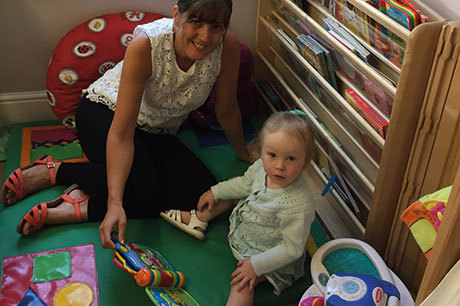
CASE STUDY: MEDWAY
Medway's baby project is being revived, writes Annette Rawstrone
Along with involving baby room practitioners and their managers, the second phase of the Baby Room Project in Medway, Kent in 2012 included a local authority advisor group from the Medway Early Years and Childcare Quality Team. The purpose of this group was to provide professional development opportunities and to support 12 advisors in developing their own network of practice in baby rooms within their area.
Advisors were supported in developing case study research drawn from observations made within baby rooms across Medway. Early education manager Kirsteen Fedder says, ‘Being part of the project was very inspiring. When Medway employed early years advisors, they were all teachers, so the majority of our experience was in nursery and Reception classes.’
The project provided the team with a deeper insight into the complexities of baby room practice along with providing rich points for discussion and consideration. Baby room practitioners also benefited from the sharing of ideas and support. Unfortunately, the local authority’s priorities shifted and the advisors stepped back from the project.
‘The group weren’t strong enough to carry on without facilitation and I have frequently reflected since that while we have some strong, skilful and very knowledgeable practitioners working across our sector, we do often need to provide a facilitative role to enable networks to be maintained and developed,’ Ms Fedder explains.
Five years on and she has been inspired to re-establish the network after attending this year’s Baby Room Conference. The first session was held last month with a deliberately loose agenda while the practitioners themselves agree some purposes for the network in order to empower them and ensure ownership is with them. ‘They identified opportunities they would like to explore around making the most of the outdoor space with babies, baby massage and supporting parents with the weaning process, so we are going about getting these elements organised for them,’ Ms Fedder says. ‘I’m really excited to see where this group of professionals will go – I feel they are real advocates for the baby room and can see we could be creating some interesting things as a network.’
On reflection:
Castle View Day Nursery, Strood 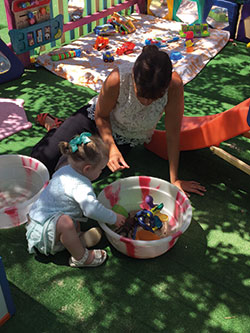
‘We were involved in the project in 2012 and our baby room leader is keen to be involved in the new one too. We want to build on what we have achieved and continue to improve our practice,’ says joint owner and manager Alison Laker.
She believes the impact of the project can still be felt in the baby room and that simple changes have led to a much calmer and stimulating environment. Now practitioners put visual stimulus at baby level rather than adult eye level, and they provide lots of different textures and natural objects for children to explore.
‘We observed that some of the younger baby room practitioners would do a task and not communicate with the babies, so now we ensure they understand the importance of communicating all the time, such as during nappy changing,’ says Ms Laker. ‘We understand that communication and baby’s brain development is so important.’
Through reflection, practitioners realised that they needed to build on learning opportunities for the babies in the garden as well as indoors, and developed a specific gated area in the garden. ‘With natural resources, bright colours and a safe space we believe this has had a positive effect on our babies,’ Ms Laker adds.
She emphasises how essential it is for baby room practitioners to be able to access training, network and share ideas. ‘We’re keen to see other advances through the new project and fully expect to have more “oh my goodness” moments when practitioners share simple ideas which can bring dramatic change,’ she says.
Phoenix Education Day Nursery, Rochester
‘Before taking part in the Baby Room Project, I would focus on the baby’s milestones such as sitting up, crawling and walking instead of thinking about how to stimulate their brain development. The project was an eye-opener,’ says deputy manager Johanna Smith, who was baby room leader in 2012. ‘It made me look more at why we do certain things and what impact it has on the children. I’ve become more reflective – questioning whether I am talking in an appropriate way for a child’s developmental age and if an activity is pitched correctly.’
Ms Smith valued being able to network with other baby room practitioners and visiting their nurseries to see their practice. ‘Unfortunately, there are few training courses for people working with babies,’ she says. ‘Perhaps it’s because of the two-year-old funding, but I think it’s also felt that babies don’t need much when it’s totally the opposite.’ She has encouraged the current baby room leader to join the new network because she feels it’s so advantageous.









